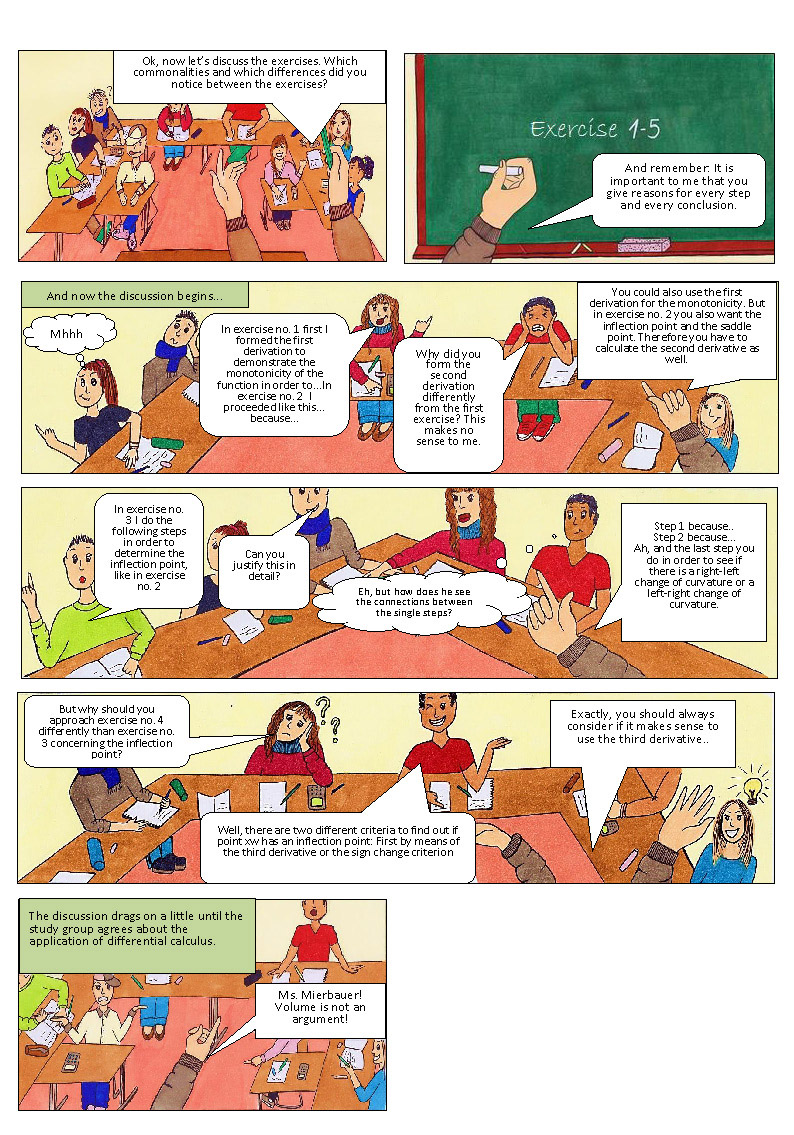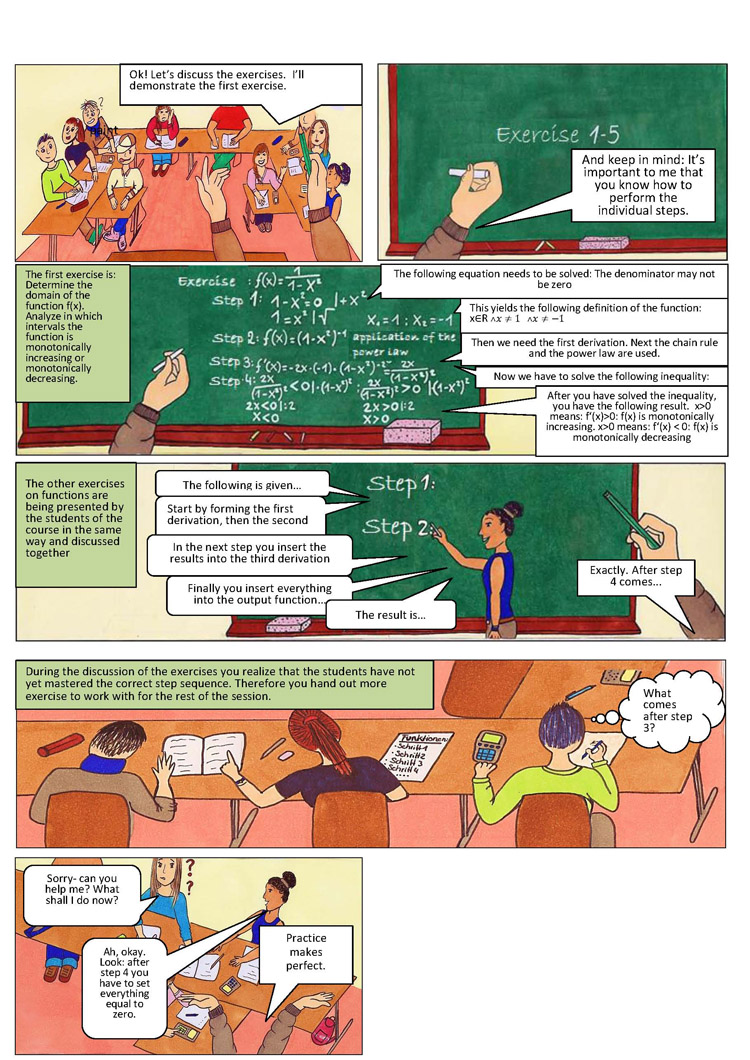When teachers explain
Freiburg, May 19, 2020
“Most teachers are well able to explain things. Yet in the school context, many of them don’t,” says Education researcher Dr. Mona Weinhuber. She investigates how teachers explain Mathematics. America’s Society for Experimental Psychology and Cognitive Science singles out Weinhuber as the best early-career researcher of 2019 in education psychology. She receives the Early Career Award for a journal article which she published together with the research unit headed by Professor Dr. Matthias Nückles, psychologist and Professor of Education at the University of Freiburg.
 Even experienced teachers may subconsciously conduct their math lessons differently from the way they really want them. Education research findings may help them counter that tendency. Photo: Robert Kneschke/stock.adobe.com
Even experienced teachers may subconsciously conduct their math lessons differently from the way they really want them. Education research findings may help them counter that tendency. Photo: Robert Kneschke/stock.adobe.com
What makes a good explanation? Matthias Nückles’ research unit has been pursuing this question for a number of years. They have found that school pupils have significantly greater learning success and better transfer when teachers teach them only the mathematical principles behind an exercise, rather than teaching the individual steps to the solution. These two ways of explaining represent two different ways of thinking. Each of these mindsets is connected with a different way of tackling mathematics, Weinhuber explains. “In university mathematics, the focus is on argumentation, whereas in school, it is on the solving of problems.”
Why the type of teaching changes
The argumentation mindset is central to most math teachers. “Yet at school they are quick to switch to the set-of-directions mindset – even though focusing on the principles in class leads to a deeper understanding,” Nückles says. “It is a well-known phenomenon that teachers act contrary to their own intentions in some situations.” In fact, math teachers often strive for lessons in which the pupils argue and discuss different ways of arriving at a solution. “But over the course of the lesson, the same thing always happens. The type of lesson changes to simply finding the answer,” Nückles explains.
 School students discuss possible solutions to the problem to get to the right answer - in this way, they learn to understand the mathematical principles behind the problem. Source: https://doi.org/10.1037/xap0000227, Grafic: Anja Mey
School students discuss possible solutions to the problem to get to the right answer - in this way, they learn to understand the mathematical principles behind the problem. Source: https://doi.org/10.1037/xap0000227, Grafic: Anja Mey
In her prizewinning study, Weinhuber investigates how this is linked to the different mindsets. She intentionally activates the teachers’ internalized mindsets, so that their explanations ultimately turned out to promote learning to a greater or a lesser degree. First, in a seemingly independent pretest, she had the teachers evaluate teaching situations in comics, thereby subconsciously activating a certain mindset. The comics show a class solving problems on curve sketching. Several teachers were given comics in which students worked through their exercises step by step; others got comics in which the pupils discussed possible solutions to the problem in order to get the right answer. Then they were given a maximum and minimum problem with constraints, in which they had to calculate the area of an arch. They had 20 minutes to write an explanation as to how to solve the problem. “Such a complex mathematical problem is not easy even for teachers. They need to concentrate hard – so much so that they are not conscious of working in a principles-oriented or step-by-step mindset,” Weinhuber stresses.
Comics activate mindsets
The teachers’ explanations were different - depending on which comic they had previously read. If, in their comic, math problems were solved via step-by-step instruction, the teachers’ explanations tended to focus on the process of calculation. If paths to a solution were discussed, the teachers focused more strongly on understanding the reasons for each step. Weinhuber’s results show that activated mindsets can get math teachers to explain by describing the steps to a solution of the problem, without shedding light on the underlying mathematical principles. They also show how easily a small, situational suggestion can activate these mindsets without the teachers noticing.
 School students work on a math problem according to step-by-step instructions - yet when math lessons follow that principle, the learning effect is smaller. Source: https://doi.org/10.1037/xap0000227, Grafic: Anja Mey
School students work on a math problem according to step-by-step instructions - yet when math lessons follow that principle, the learning effect is smaller. Source: https://doi.org/10.1037/xap0000227, Grafic: Anja Mey
If just one comic is enough to so fundamentally influence the explanations of experienced teachers - the stronger the influence of everyday social interaction in the mathematics classroom must be. “Teachers have both mindsets,” Weinhuber says, “But the situational context of the classroom usually sets off the instructional mindset.” This mindset may be strongly anchored among the students - such that they usually only want to follow the steps to get at the answer. “Teachers quickly give in, subconsciously letting themselves be led by the students, and stop basing their math lesson on arguments,” Nückles adds. The instructional mindset sees teachers subconsciously orienting their explanations towards the process instead of the principles. This in turn makes the pupils expect such step-by-step explanations.
The jury selected Weinhuber’s article unanimously from the Early Career Award nominations. The works nominated were the outstanding contributions for 2019 from five specialist journals. The Society for Experimental Psychology and Cognitive Science gives the award to promising early-career researchers. Weinhuber is to receive the prize in August 2020 at the meeting of the American Psychological Association in Washington, DC.
Improving teaching
How can these results help teachers to raise their game? “They have to be aware that school culture animates subconscious processes and mindsets,” Weinhuber says. Both during preparation and in class, teachers can use this knowledge to purposely activate their mindsets and improve their teaching. “We have seen that even a brief, subconscious jolt to one mindset transfers it to other tasks,” Weinhuber summarizes. The findings are already being used in teacher training and in information leaflets at schools. Further training may also help sensitize teachers. “Teaching videos are a central approach. By looking at their own teaching, teachers are better able to talk about it,” says Nückles. In this way, discrepancies between the planning and the carrying out of lessons can be identified – and teachers may become aware that they may act differently from the way they really want to.”
Sarah Schwarzkopf

